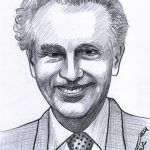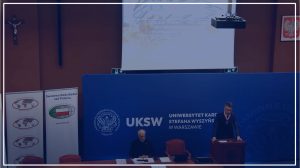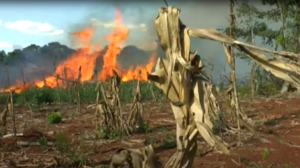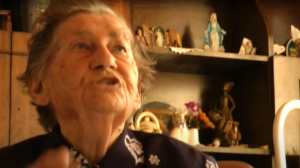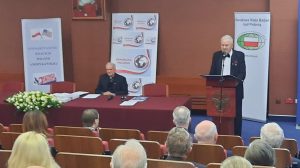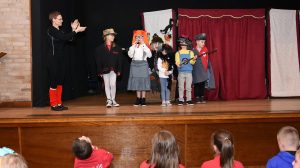Natalia Bryl,
Jan Stangryciuk-Black: One of the last Polish Heroes from the Battle for Britain
PICTURES:
Figure 1, Jan Stangryciuk (right) on his return to the 300 Bomber Squadron after undergoing over twenty reconstructive plastic surgeries for his burns. He returned to serve out of his own will.
Figure 2, The Remains of Wellington DV802 after its crash in October 2nd 1942. Jan Stangryciuk-Black was severely injured, whilst the two remaining airmen – Mariam Hesse and Edmond Stan Mistecki – did not survive.
British historian David Reynold once referred to the idea that our memory of wars only endures within the present day largely due to the continued human presence of the past. With the Second World War receding further into the past, with fewer people left to remember it directly, how can we preserve the memory of our war heroes? How can the experience of war be truly understood and shared between generations? They say that knowledge speaks, but wisdom listens…
October 23rd 2023 marked the death of one the last remaining Polish heroes of the Battle of Britain – Lieutenant Jan Strangryciuk-Black. After coming to Britain to serve in the Polish Air Forces, Jan flew as the rear gunner aboard both Wellington and Lancaster bombers in the 300 ‘Land of Masovia’ Polish Bomber Squadron. Despite experiencing serious burns after his Wellington bomber crashed during training in 1942, Jan went on to complete eighteen combat operations for the Royal Air Force. The Bomber Command was responsible for destroying much of the armament, transport, radar and communications infrastructure of Germany and Occupied Europe. By remembering Jan’s experiences, war ceases to merely be something inside our history books or a distant concept – but a real, living thing, even for those who do not hold it as part of their memories.
Jan was born on April 18th 1922 in Eastern Poland, Chełm. His recollections of Poland were a simple life; a life of family and friends and of agriculture. In 1934, his family migrated to Argentina, hoping for new opportunities with circling talks of it being a ‘huge, big, empty, new land’.[2] On arrival, Jan’s father brought land and started a plantation. Five years after his family settled in Misiones; a large province located near the Brazilian border, the German invasion of Poland was announced at the start of September 1939. At eighteen, Jan travelled to Buenos Aires after seeing advertisements in English newspapers urging for volunteers for the war. When he arrived, he declared his intentions to join and serve the British Armed Forces.
Two weeks after signing up, Jan received a notice at 6 am, notifying him the limited details of his departure to England. The date and time of the ship’s departure was kept confidential to prevent information from reaching German espionage, who were known to circle around accommodations. It was only six hours prior to the Highland Monarch’s departure that the volunteers were informed about the start of their voyage. They were placed on a ship that was exporting meats and other food supplies into England. The duration of the course to Belfast, Northern Ireland, increased from a typical three-week journey to four weeks as the boat zig-zagged across the Atlantic to avoid being identified and sunk by German submarine U-boats. The sense of danger was even prevalent when Jan slept in his hammock, with volunteers being urged to wear their ‘Mae West’ lifejackets whilst sleeping.
After docking in Belfast, Jan was soon moved to the military barracks in Scotland for his medical exam. Upon passing, he requested to join the Polish Air Force that had recently been formed in Britain. He was granted permission. Not only was the Air Force the most popular and ‘exciting’ unit to join amongst young men, it also allowed Jan to maintain his sense of Polish identity. It was his Polish roots and his patriotic feelings for his country, especially in its harrowing struggle, that drew him towards the role. After the German invasion of Poland, Great Britain had agreed to accept around 18,000 airmen into the Polish Air Force in Britain.[3] The Polish airmen; for their exploits, their unsurpassed gallantry, and their dedication to serve, won them respect throughout England.
Jan was moved to Blackpool, in which one of the first bases for the Polish Air Forces was located. To complete elementary training, Jan learnt the rudiments of meteorology and air navigation. In addition, Polish airmen also had to cover the basics of the King’s regulations and the English Language. Airmen were taught how to recognise both British and German aircrafts on cinema screens. All crews were advised to take photographs during missions to monitor their success rates, and to note the locations they bombed and their displacement from the original target. It was thanks to the Anglo-Polish Agreement of 1939 that allowed for the Polish Armed Forces to be organised and employed under British Command. The majority would still be subject to Polish military law and disciplinary ruling.[4] Two years prior to Jan’s entrance into the RAF in Bramcote, the site welcomed Polish Prime Minister General Władysław Sikorski for an inspection of the Polish squadrons on August 7th 1940. In the following days after the visit, General Sikorski sent a message expressing his immense satisfaction with his airmen. He revealed that he was received with ‘the utmost respect and goodwill, and everywhere [he] found [his] men in splendid form.’[5]
At the time of Jan’s arrival in Blackpool, the only available vacancy for training was the role of an air gunner. The position of a pilot required more rigorous training. After entering the 18 Occupational Training Unit, Jan’s crew was sent on missions to drop propaganda leaflets over Vichy, France. It was a mission that bore hope for the people of France as the leaflets proclaimed that their liberation is soon come.
However, during his return home on the October 2nd 1942, his Wellington bomber (DV802) received an engine defect and crash landed near Ryton, Warwickshire, just before reaching the aerodrome.[6] Not all planes within the Royal Air Force were fortunate to be completely airworthy. Due to the intensity and frequency of the missions within the Royal Air Force, many servicemen were not able to keep up with the ongoing demand for less crucial repairs. Many a time, even if crew noticed a small defect before take-off, nothing could be done. Upon descend, with only seconds to go, Jan would remember praying for a miracle as he recognised they were approaching a potential end …
Upon impact, Jan’s helmet was thrown off and he subsequently lost consciousness.[7] Whilst the very aircraft was in flames, Jan managed to regain consciousness. Rather than searching for an exit, he immediately crawled to the front of the plane from the rear turret in order to try and save his pilot, Sergeant Marian Hesse. However, the smoke in the aircraft made orientation impossible. Jan made multiple attempts to untie Hesse’s seatbelt, yet ultimately was unsuccessful. With flames engulfing the plane increasingly, Jan was in extreme danger of not making it out himself. With his left hand covering his face, and his right struggling to find an exit, Jan realised that the fuselage had broken into two parts due to crash’s impact. He crawled back to where the Wellington had split in half and groped his way out through the skylight exit. It was a miracle that Jan’s life was spared.
After finally scrambling out and making it to the ground with a burning flying suit, Jan received help from local farmers. Moments later, at a distance, the Wellington exploded. Jan suffered serious third-degree burns to his face and hands. In the initial stages after the crash, his vision was damaged, and Jan recalled that he could not see. In an interview with Chris Brockbank, Jan described the fire as ‘the greatest enemy’ one could have faced on a mission… the worst of all the elements. On that day, Jan lost both his crew members: Mariam Hesse and Edmond Stan Mistecki. He was the only one to survive. For the remaining years of his life, the left side of Jan’s face remained scarred from the accident, whilst the right sustained significantly fewer scarring.
The ambulance arrived around half an hour from the time of the crash and Jan was immediately wrapped in bandages, soaked in oil; to prevent them from sticking to his skin. During the journey, Jan recalled that his thoughts were always with his crew and the terrible shock he was in when he heard of their deaths. Jan had explained how they were bound together for life or death.
He was taken to the Cosford Hospital near Wolverhampton for treatment. His pain was so excruciating in the following days that he was administered morphine. However, thanks to the experimental therapy of New-Zealand doctor Archibald McIndoe, one of the most well-known plastic surgeons in the RAF (who happened to be at the Cosford Hospital for an inspection), most of Jan’s facial injuries were repaired. McIndoe later recommended that Jan be transferred to the Queen Victoria Hospital in East Grinstead in which he was based. Jan gratefully accepted and placed his complete trust and process of recovery in the hands of McIndoe. Throughout the course of two years, Jan underwent over twenty reconstructive operations to his nose, ears, and cheeks. If it was not for McIndoe, Jan would have also lost the ability to move his fingers.
Thanks to McIndoe, Jan was not only recovering physically, but mentally. He described that he arrived at the hospital mentally broken. However, on arrival at the hospital, Jan immediately felt as if part of a family; surrounded by Canadians, Poles, Czechs and English. He received continuous encouragement from staff who exclaimed that they all would soon become as they were before. During his time there, Jan became a member of the Guinea Pig Club; a club founded by Sir McIndoe in July 1941 to support aircrew who were undergoing reconstructive plastic surgery for burn injuries.[8] It had united 649 members by the end of the Second World War, including at least fifteen Polish airmen. By 1945, 80% of the club’s members were bomber aircrew.[9] And since the majority of McIndoe’s methods for treatment were pioneering and experimental, patients compared themselves to guinea pigs. This, in fact, was the inspiration for its name. Despite the life-changing disabilities of some members, the club offered aircrew a sense of hope. The Guinea Pig Club challenged the perceptions that these disfigurements were life-limiting. Jan would speak of the camaraderie of soldiers and then of their favourite song: Vera Lynn’s ‘We Will Meet Again.’ Perhaps one of the most poignant wartime songs; its soothing melody and hopeful message was imprinted onto the lives of many soldiers: boosting morale amongst the men. In 2016, Jan mentioned: ‘I am old now, but I still feel that I am young because that song gave us so much spirit’.
Amongst other factors, it was the strain of the war and the proximity of the men who were hospitalised that created a unique environment for the development of unbounded friendships. During Christmas of 1942, men would listen to Bing Crosby’s ‘White Christmas’ at Queen Victoria hospital. The room would be soaked in a dim light and on reflection, the value of this memory would overcome Jan, so much so, that it would evoke tears in him. It was a soulful song – a song of longing.
Beyond the Guinea Pig Club, the cohesive fellowship of men proved essential within the Bomber Command. During missions, they ensured operational efficiency due to fluent communication between crew. When not on missions, Jan would recall the times the airmen played snooker and bridge, or sought refuge and relaxation at local pubs. Occasionally, they would go on daytrips together. They would share everything; some would pay for each other’s return train-tickets, others might pay more for another man’s lodgings. During a time in which airmen witnessed the removal of hope, dignity, luxury and even sometimes self-withdrawal, selflessness was an indisputable notion during the war.
In 1943, after completing most of his most necessary surgeries, Jan was moved from East Grinstead to Evanton, Scotland. Once there, he became an instructor for beginner gunners; teaching them how to fire from Boulton twin engine planes and how to understand distance whilst in the air. He was based there for three months as part of his recovery before receiving notice that he may return to Bramcote and report to his commanding officer.
With his training complete, Jan was asked what occupation he would wish to have within the Royal Air Force. He replied ‘Sir. […] I want to do what I’ve been trained to do. I want to fly.’ After crashes like the one of October 2nd 1942, airmen did not usually return to flying. However, Jan was committed to continue, despite also being advised to reconsider by the commanding officer. If his plane would have been shot down over Germany, he would not be welcome with his Polish profile. Jan’s service to the Polish Air Force was one of no hesitation and vigorous commitment.
Jan passed his tests to ensure he was fit enough to fulfil his professional responsibilities when flying. After two days, the Commanding Officer reported that Jan was able to resume his duties at the RAF in Faldingworth in full confidence. Jan joined the 300 ‘Land of Masovia’ Polish Bomber Squadron in November 1943. The 300 and 301 Squadrons largely operated alternatively, with it being said that many a time the two squadron commanders would throw dice to decide which would take the next mission.[10] By this point, the Bomber Command was able to sustain between 700-1000 aircrafts, which had the potential to deliver 2000 tons of bombs on a target in one bombing raid.[11] Before each bombing raid, Jan would be briefed on the objective of the raid, on the size of the bombing force, on potential danger spots along their route for flak and night fighters and also on the weather conditions.
Jan’s first operation was a bombing mission over an arms manufacturing factory in Gelsenkirchen. ‘It was hell’: he would describe, as he recollected on the bombings, the burnings below and the threat of the constant searchlights. Conditions within the aircraft for the crew were also life-threatening. Flying at over 10,000ft required aircrew to wear oxygen masks, whilst flying at 20,000ft meant that temperatures could drop to -40 degrees centigrade. The sole heating would be from adjustable and flexible pipes from the engines. Air gunners, like Jan, would have electrically heated suits. On other missions, Jan would recount other German methods to take down aircrafts. Amongst many, was the use of suspended balloons, where the lines were intended to hook British planes. To his luck, Jan recalls never having to shoot down German aircraft.
After joining Squadron 300, Jan completed eighteen operations over Essen, Dusseldolf, and other German locations before being recalled to Queen Victoria hospital to complete final treatment for his facial injuries. It was this recall, that was to save his life inadvertently. After three days since leaving the base, Jan received a letter informing him that his crew were flying on a bombing mission to the Rhenania Ossag oil refinery. Although the February weather conditions were also not ideal for marking and bombing, it was ultimately a flak, an anti-aircraft fire, that caused their plane to crash. Their Lancaster I was shot down over Leverkusen, Germany, on the night of the February 20th 1945. The location of the plane crash on the southern fringe of the Ruhr suggested that the crew were already homebound towards Belgium. Pilot Jan Konarzewski and navigator Stanisław Modrany were both killed.[12] The remaining crew parachuted into the arms of their captors and were taken as prisoners of war. They were all thought to have escaped except for one: Władysław Jakimowicz. Jan compared that the intensity of his grief was the same as if losing a father or a brother. The bombing of Germany and occupied Europe had a 46% death rate within the Air Force by the end of the Second World War.
When Jan finished his treatment, the Second World War had ended. He was transferred to the Royal Air Force Station in Hampshire to continue his service until 1948, guarding the aerodrome for any landing plans.
In 1948, he received his discharge from the Dunholme Lodge in Lincolnshire. Jan’s squadron, Squadron 300 of the Masovian Region, lost four times as many pilots as 303. On departure, Jan was given his ‘demob suit, demob shoes, two shirts and some compensation money’ and went quietly back amongst the living. ‘And that’s how I ended my service in the Royal Air Force in 1948.’ The story of Jan’s life, the one he shared with us in a myriad of interviews, is one that many of us will never have the capacity to comprehend.
Under pressure from Stalin, the British Labour government did not invite the Polish Armed Forces to the Allied Victory Parade, despite that Poles constituted the fourth largest group of Allies. After a myriad of complaints in Parliament and from the Royal Air Force regarding the lack of invites to Polish soldiers in Britain, a small group of pilots were finally sent invitations. Many had declined. Jan was the only Pole to take part in the Allied Victory parade on June 8th 1946.
In October 1946, Jan married Evelyn Black, whom he met during the war at a dance function in Hammersmith. During the end of the war, she would visit Jan at Queen Victoria hospital, knowing he had no relatives in the country. After the war, Jan wished to take Evelyn to Argentina to meet his family. However, on arrival at the Argentinian Embassy in London, Jan was advised to delay his trip by eight years due to the increasing amount of German Nazi communities in South America. It was Sir Archibald McIndoe that recommended Jan to apply for a British passport and made further suggestions for him to take his wife’s maiden name – Black. Thanks to this advice, Jan was able to travel to Argentina with his wife, as Jan Black. They bought a home together in Holland Park and lived together for fifty-two years until Evelyn’s death in 2009.
Even though the war had ended, the Yalta agreement of February 1945 triggered ongoing hostilities between Poland and Russia. Border issues were still being negotiated up until 1951. Hence, due to political reasons, Jan did not return to Soviet-dominated Poland and decided to stay in England. In 1947, the British Government had instituted the Polish Resettlement Program, giving rights of employment, residence, and other benefits to Polish veterans. Jan started a job at the Woolf Rubber Factory in Southall, doing twelve-hour night shifts daily with Sundays off. Jan was later promoted to supervisor. After twelve years he moved to work at Clark’s Electrical Company in Willesden. After twenty-two years, the company was sold, and Jan had reached his retirement age.
Jan led a simple life; one of humility. Despite his struggle high above the earth during his missions, Jan was happy with how he started, with how he ended, because his country ‘today is free’: ‘I am happy that my country has recognition and honour.’ Jan later remarried to Jadwiga Jasińska, with whom he lived with in Ealing until his death. Throughout his life after the war, he continued to attend annual meet-ups with the Guinea Pig Club. Often present amongst the men was Duke of Edinburgh, Prince Philip, who took over as president of the club following Sir Archibald’s death in 1960. One of the Prince’s last public engagements was to unveil the Guinea Pig memorial statue at the National Memorial Arboretum in 2016. Memorials like these are an important part in consolidating public memory. Jan Strangryciuk-Black was the last surviving member of the Guinea Pig Club.
In the following years after the war, Jan was awarded with the Polish Cross of Valour, the Polish Air Force Medal, the Aircrew Europe Star, the King George and lastly, the Bomber Command Medal. Two years ago, Jan was promoted to the rank of Second Lieutenant by Polish President Andrzej Duda. This September at RAF Northolt, he was promoted to the honorary rank of Lieutenant.
Not many things tend have value until one realises what they can do for us. How can preserving the memory of war heroes like Jan Strangryciuk-Black make us accomplish something in present time? Jan’s war efforts might, to us, seem beyond recall or imagination, sanitised, and relegated to another world. Hence, it becomes absolutely vital to remind ourselves and future generations – the vessels of memory – the reality of the Second World War. We must remind ourselves who lies behind our liberated countries and who we have to thank for. We must recognise their willingly endured hardships and fears, taken upon themselves so that we could live in peace. It is only when history is actively transmitted to us, whether through conversation or reading, that we can accept it as meaningful. This is exactly what Jan Strangryciuk-Black offered in his final years: sharing with us his moving and engrossing story.
The Second World War has become an indelible part of not only British and Polish history, but their culture, identity, and consciousness. It is the nostalgic experience of remembrance that triggers within us the urge to be inspired and motivated again. When we practise remembrance, we exercise and reinforce feelings of national pride. We may not be able to fully comprehend what it feels like to return from a day of missions to an empty dining table, but what we have is memory: a memory of Jan’s unwavering service, his contributions to the development of Britain, and his advice of us to consider the way in which past histories, though long gone, have the ability to remarkably impact our present conflicts. When we listen, we learn of the virtues that enabled his acts of perseverance despite agonising struggles.
We must not let fatigue or ignorance allow so many memories to fade into the abyss. The obligation to remember is hailed out on every Remembrance Day, on anniversaries of battles, on parades. However, even the words ‘Lest We Forget’ may eventually become irksome through repetition when one is not thoroughly reminded of their reason. By remembering, we tacitly salute Jan Strangryciuk-Black’s patriotism for Poland, and his bravery and endurance when defending the British skies. We must let our remembrance surpass beyond November 11th. We may acknowledge and momentarily ponder about the grappling sacrifices of so many servicemen on that day, but to permit our remembrance to linger beyond just a singular day is the truest form of regard and understanding. We will never see their like again.
BIBLIOGRAPHY
PRIMARY SOURCES:
Strangryciuk-Black, Jan, ‘Interview with Jan Black. One’ conducted by Thomas Ozel. 10 July 2016. https://ibccdigitalarchive.lincoln.ac.uk/omeka/collections/document/3494 .
Strangryciuk-Black, Jan, ‘Interview with Jan Black. Two’ conducted by Chris Brockbank. 14 March 2017. https://ibccdigitalarchive.lincoln.ac.uk/omeka/collections/document/8766
SECONDARY SOURCES:
‘Fund pays tribute to Guinea Pig Club members’ (2023), https://www.raf-ff.org.uk/fund- pays-tribute-to-guinea-pig-club-members/
Kacewicz, George, Great Britain, the Soviet Union and the Polish Government in Exile (Dordrecht: Martinus Nijhoff, 1979)
‘Life and Death in Bomber Command’, Imperial War Museums, https://www.iwm.org.uk/history/life-and-death-in-bomber-command
Reynolds, David, The Long Shadow: The Great War and the Twentieth Century (London; New York: Simon & Schuster Ltd, 2013)
‘The Polish Air Force’ from Virtual Bunker, https://battleofbritainbunker.co.uk/polish-air- force/
Ward, Chris and Korcz, Grzegorz, ‘300 (Masovian) Sqaudron’ from RAF Bomber Command Squadron Profiles, (Yorkshire: Mention the War Ltd, 2016)
‘Wellington IC DV802’ from the Royal Air Force Commands, https://www.rafcommands.com/database/serials/details.php?uniq=DV802
Wilson, Reg, ‘Bomber Command and Notes of Some of My Experiences During 1941-1945’, IBCC Digital Archive, (2000), https://ibccdigitalarchive.lincoln.ac.uk/omeka/collections/document/35819
’20,02/1945 No. 300 (P) Squadron Lancaster I PB722’, Aircrew Remembered, https://aircrewremembered.com/konarzewski-jan.html
[1] David Reynolds, The Long Shadow: The Great War and the Twentieth Century (London; New York: Simon & Schuster Ltd, 2013), pp.433.
[2] Jan Strangryciuk-Black, ‘Interview with Jan Black. Two’ conducted by Chris Brockbank. 14 March 2017. https://ibccdigitalarchive.lincoln.ac.uk/omeka/collections/document/8766.
[3] ‘The Polish Air Force’ from Virtual Bunker, https://battleofbritainbunker.co.uk/polish-air-force/.
[4] George Kacewicz, Great Britain, the Soviet Union and the Polish Government in Exile (Dordrecht: Martinus Nijhoff, 1979), pp. 61.
[5] Chris Ward, pp. 12.
[6] ‘Wellington IC DV802’ from the Royal Air Force Commands, https://www.rafcommands.com/database/serials/details.php?uniq=DV802 .
[7] Jan Strangryciuk-Black, ‘Interview with Jan Black. One’ conducted by Thomas Ozel. 10 July 2016. https://ibccdigitalarchive.lincoln.ac.uk/omeka/collections/document/3494 .
[8] ‘Fund pays tribute to Guinea Pig Club members’ (2023), https://www.raf-ff.org.uk/fund-pays-tribute-to-guinea-pig-club-members/ [accessed 12 November 2023].
[9] ‘Life and Death in Bomber Command’, Imperial War Museums, https://www.iwm.org.uk/history/life-and-death-in-bomber-command [accessed 18 November 2023].
[10] Chris Ward, pp. 15.
[11] Reg Wilson, ‘Bomber Command and Notes of Some of My Experiences During 1941-1945’, IBCC Digital Archive, (2000), https://ibccdigitalarchive.lincoln.ac.uk/omeka/collections/document/35819, pp. 2.
[12] ’20,02/1945 No. 300 (P) Squadron Lancaster I PB722’, Aircrew Remembered, https://aircrewremembered.com/konarzewski-jan.html.


